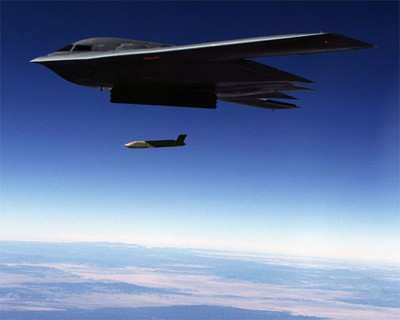 When the Air Force
successfully launched its newest cruise missile for the first time
on May 18, it marked a significant step toward making the job of
the pilots who deliver the weapon a lot less risky.
When the Air Force
successfully launched its newest cruise missile for the first time
on May 18, it marked a significant step toward making the job of
the pilots who deliver the weapon a lot less risky.
A B-1B Lancer released the Joint Air-to-Surface Standoff Missile
-- Extended Range over the White Sands Missile Range in the New
Mexico desert. The missile successfully cruised more than 400
nautical miles to its static target of cargo containers.
“The system is remarkable,” said Col. John Griggs,
308th Armament Systems Group commander, whose unit at Eglin works
with the contractor to develop the system. “It was a
low-risk, low-cost upgrade.
“We already know the JASSM is stealthy and lethal,”
he said. “But with the new upgrade, it can travel more than
500 nautical miles (compared to the old system’s range of
about 200 nautical miles).”
This greater range translates to huge benefits to the aircrews
that launch these missiles.
“There are mothers and fathers, sons and daughters out
there who put themselves in harm’s way to deliver these
systems,” Colonel Griggs said.
 “The extended
range allows them to deliver that punch at a safer distance. This
is important when you consider that the enemy is constantly
improving their ability to shoot down our aircraft at a longer
distance.”
“The extended
range allows them to deliver that punch at a safer distance. This
is important when you consider that the enemy is constantly
improving their ability to shoot down our aircraft at a longer
distance.”
The stealthy cruise missile is an autonomous, conventional
munition designed to defeat heavily defended, high-priority enemy
targets deep behind enemy lines. Although it looks the same and
provides all the capabilities of the baseline missile, it has a new
engine and larger fuel load capability. This allows it to extend
its range.
And it is still deadly accurate to within three meters, the
colonel said.
Still in the development test phase, testing will go from a
crawl, to a walk, to a run state, Colonel Griggs.
“Yesterday’s launch was a crawl,” he said.
“But it was a hell of a crawl.”
Although the launch didn’t test the new missile’s
maximum range, the 51-minute flight puts it well on the way to
making the battlefield a safer place for aircrews to work.
“This was the culmination of a lot of hard work by a lot
of people within the JASSM–ER team,” said Lt. Col.
Stephen Davis, JASSM Block 2 Squadron commander. “Everything
went as planned, and the launch was a total success.”

Adding to the success is the economical way improvements were
made.
“These low risk modifications were made without disturbing
the missile’s outer shape and size, thus reducing the cost
and development time for the effort,” said Mike VandenBoom,
the missile’s chief engineer.
Like the original JASSM, the new missile uses its inertial
navigation and global positioning systems to find its intended
target and then its infrared seeker for pinpoint accuracy right
before impact.
Aircraft can release the missile in virtually any weather and
with its extended range will provide combatant commanders another
tool once it reaches the Air Force inventory. It should arrive in
fiscal 2009. The B-1B is the missile’s threshold aircraft.
But plans are in the works to integrate it onto other systems.

“Like the baseline version (B-1B), JASSM–ER will be
capable of employment from the B-2, B-52, F-15 and F-16,”
JASSM-ER test engineer Buff Tibbetts said.
The launch was the first in a series of flight tests scheduled
to run through December 2008. [ANN Thanks Master Sgt. Timothy P.
Barela, AFPN and Staff Sgt. Ryan Hansen of Eglin’s Air
Armament Center Public Affairs Office, who contributed to
this article]
 Unfortunate... ANN/SportPlane Resource Guide Adds To Cautionary Advisories
Unfortunate... ANN/SportPlane Resource Guide Adds To Cautionary Advisories ANN FAQ: Turn On Post Notifications
ANN FAQ: Turn On Post Notifications ANN's Daily Aero-Term (04.29.24): Visual Approach Slope Indicator (VASI)
ANN's Daily Aero-Term (04.29.24): Visual Approach Slope Indicator (VASI) ANN's Daily Aero-Term (04.28.24): Airport Marking Aids
ANN's Daily Aero-Term (04.28.24): Airport Marking Aids ANN's Daily Aero-Linx (04.28.24)
ANN's Daily Aero-Linx (04.28.24)






